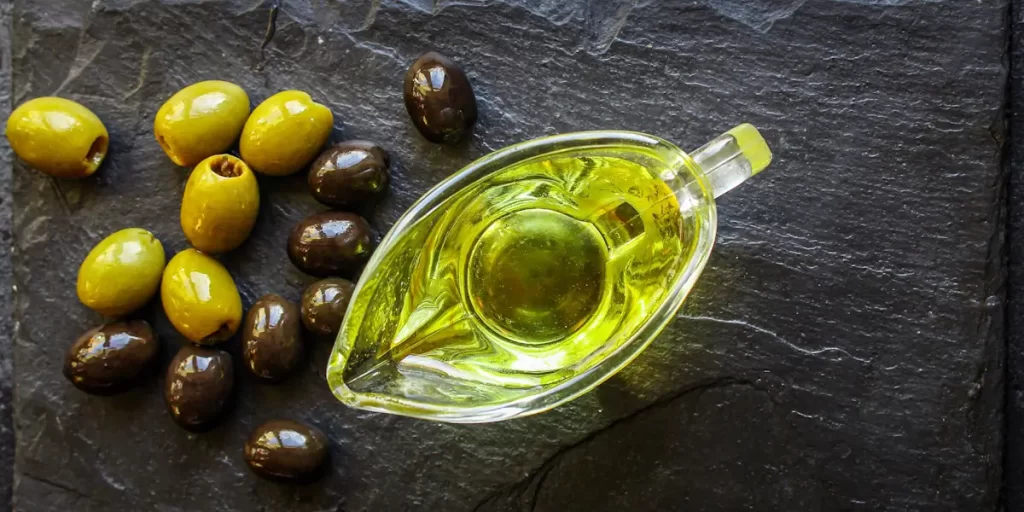Managing diabetes can feel overwhelming, especially for women at risk of type 2 diabetes. Studies show that olive oil consumption may lower this risk significantly. This blog explains the science behind olive oil’s benefits and how it supports better health.
Thank you for reading this post, don't forget to subscribe!Keep reading to discover an easy way to improve your diet today!
Key Takeaways
- Women who consume at least one tablespoon of olive oil daily may lower their risk of type 2 diabetes by 10%. Replacing butter or mayonnaise with olive oil reduces T2D risk by up to 15%.
- Olive oil is rich in monounsaturated fats (71%) and antioxidants like polyphenols, which reduce inflammation and support better blood sugar control. Extra virgin olive oil (EVOO) offers the most health benefits.
- Long-term studies like NHS and NHS II, involving over 145,000 women across 22 years, showed higher olive oil intake links to a modestly lower diabetes risk compared to non-consumers.
- Clinical trials, including the PREDIMED study, found EVOO improves insulin sensitivity while lowering cardiovascular risks by up to 26%. Common olive oils had lesser benefits or higher risks.
- A Mediterranean diet featuring olive oil supports heart health, weight management, and reduced chronic disease risks when paired with vegetables and lean proteins. Portion control is key due to its high calorie content.
The Link Between Olive Oil and Diabetes Risk
Women who consume olive oil may lower their risk of type 2 diabetes (T2D). Studies show eating more than one tablespoon daily can reduce the risk by about 10%. Replacing less healthy fats, like butter or mayonnaise, with olive oil makes a difference.
Substituting eight grams of butter with olive oil lowers T2D risk by 8%. For mayonnaise, the reduction jumps to 15%.
Long-term studies back this up. Over 22 years in the Nurses’ Health Study (NHS), researchers recorded thousands of T2D cases—5,738 in NHS and another 3,914 in NHS II. Women adding olive oil into their diets during this time had better outcomes compared to non-consumers.

Key Nutritional Components of Olive Oil
Olive oil is rich in nutrients that support overall health. Its unique blend of fats and antioxidants helps the body function better.
Healthy monounsaturated fats
Monounsaturated fats make up about 71% of olive oil. These fats, especially oleic acid, play a key role in reducing inflammation. They also help lower oxidative stress, which can damage cells over time.
Replacing unhealthy fats like stick margarine with olive oil adds these healthy monounsaturated fatty acids to the diet. This simple switch supports blood sugar control and reduces cardiometabolic risk factors linked to type 2 diabetes (T2D).
Antioxidants and polyphenols
Olive oil contains high amounts of antioxidants and polyphenols, which protect the body from damage caused by free radicals. These compounds are especially abundant in virgin olive oil (VOO), making it a powerful choice for improving health.
Hydroxytyrosol, a key phenolic compound in VOO, plays an important role in lowering cardiovascular disease (CVD) risk.
Studies show that olive oil’s phenolic content helps fight inflammation and improve heart health. This benefit can support better blood sugar control and reduce type 2 diabetes risks.
Adding this healthy fat to your diet provides natural protection against chronic diseases while boosting overall wellness.
Evidence from Research Studies
Studies show women who consume olive oil may have a lower risk of developing type 2 diabetes. Research highlights its potential to improve health through better insulin management and reduced inflammation.
Epidemiological studies on women
Epidemiological studies provide valuable insights into health trends among populations. The Nurses’ Health Study (NHS) and Nurses’ Health Study II (NHS II) offer critical data on the relationship between olive oil consumption and Type 2 Diabetes (T2D) risk in women. Below is an overview of the findings:
| Study | Population | Age Range | Duration | Key Findings |
|---|---|---|---|---|
| NHS | 59,930 women | 37-65 years | 22 years | – Identified 5,738 cases of T2D. – Higher olive oil intake linked to modestly lower T2D risk. |
| NHS II | 85,157 women | 26-45 years | 22 years | – Found 3,914 cases of T2D. – Similar results showed reduced risk with higher olive oil consumption. |
The studies spanned decades, involving over 145,000 women. Findings suggest that olive oil may play a role in reducing diabetes risk. Participants who consumed more olive oil had consistently better outcomes than those with lower intake.
Clinical trials and their findings
Clinical trials have explored how olive oil impacts health, specifically focusing on reducing diabetes risk. These studies provide crucial insights into how consuming olive oil benefits the body.
| Study Details | Key Findings |
|---|---|
| PREDIMED Study (2003–2010) Analyzed the Mediterranean diet’s impact on cardiovascular health in 1,837 participants. | – Total olive oil reduced cardiovascular risk (HR = 0.79, CI: 0.67–0.92). – Extra virgin olive oil (VOO) reduced risk by 26% (HR = 0.70, CI: 0.59–0.83). – Common olive oil (COO) linked to a 26% higher risk (HR = 1.37, CI: 1.15–1.63). |
| VOO and Inflammation Focused on effects of VOO on inflammation and insulin resistance. | VOO reduced markers of inflammation, improving insulin sensitivity. |
| Fat Substitution Studies Assessed replacing saturated fats with olive oil in diabetic patients. | Substitution led to better blood sugar control and improved lipid profiles. |
These findings highlight olive oil’s role in preventing diabetes while improving overall health.
How Olive Oil May Reduce Diabetes Risk
Olive oil can help the body process sugar better, which may lower diabetes risk. It also supports overall health by reducing harmful effects linked to chronic illnesses.
Improving insulin sensitivity
Extra virgin olive oil (EVOO) helps the body use insulin better. It can improve how cells respond to insulin, lowering blood sugar levels. Diets rich in EVOO have shown better glucose tolerance compared to those with lard-based fats.
This aids in managing type 2 diabetes (T2D). EVOO’s monounsaturated fatty acids (MUFA) and antioxidants play a big role here.
By supporting pancreatic beta-cell function, EVOO can help regulate blood sugar more efficiently. Antioxidants reduce oxidative stress—a factor linked to poor insulin sensitivity.
Women who consume healthy fats like EVOO may see improved cardiometabolic health over time, reducing risks of T2DM and related conditions.

Reducing inflammation
Olive oil’s monounsaturated fatty acids (MUFA), such as oleic acid, help lower inflammation. Chronic inflammation can trigger type 2 diabetes (T2D). By calming this internal “fire,” olive oil may protect against T2D and its effects.
Its antioxidants, including polyphenols, also reduce oxidative stress—a key driver of inflammation in the body.
Including extra-virgin olive oil regularly may improve overall health by targeting these issues. This benefit links to its role in improving insulin sensitivity… paving the way for better diabetes prevention strategies.
Supporting heart health
Replacing just one teaspoon of butter or stick margarine with olive oil can lower cardiovascular disease risk by 5%. This simple change helps cut down on unhealthy trans fats, which harm heart health.
Olive oil is packed with monounsaturated fatty acids (MUFA). These healthy fats improve cholesterol levels and reduce the risk of coronary heart disease.
Daily consumption of over half a tablespoon has even bigger benefits. Studies show it cuts cardiovascular disease (CVD) risk by 15% and lowers coronary heart disease risk by 21%. Its antioxidants, like vitamin E and polyphenols, fight inflammation.
Over time, this reduces strain on blood vessels and supports overall cardiovascular function.
Recommended Olive Oil Consumption for Women
Women can enjoy olive oil daily by using it in simple ways like drizzling it on salads or swapping it for less healthy fats—discover more easy tips ahead!
Daily intake guidelines
Consume at least one tablespoon of olive oil daily. This simple step may lower the risk of type 2 diabetes (T2D) by 10% in women. Use it as a salad dressing, drizzle over cooked vegetables, or mix into meals.
Replace unhealthy fats like butter or mayonnaise with olive oil. Research links this substitution to a 15% reduced T2D risk. Opt for extra-virgin varieties for better nutrients and flavor.
Choosing high-quality olive oil
Choose extra virgin olive oil (EVOO) for better health benefits. It is rich in phenolic compounds, which help reduce the risk of cardiovascular diseases and type 2 diabetes. High-quality olive oil also contains more antioxidants and healthy fats than regular options.
Use over one tablespoon daily for the best results. Substitute EVOO for butter or stick margarine to improve your diet. Long-term use can lower diabetes risk while boosting overall health in women.

Substituting Olive Oil for Less Healthy Fats
Swap butter or margarine with olive oil—it’s a simple change that can boost your meals and health. Read on to see how easy it is!
Benefits of replacing butter and margarine
Switching from butter and stick margarine to olive oil can improve health. Substituting just 10 grams of these fats with olive oil daily lowers total mortality risk by 8-34%. This includes reducing the chances of dying from cardiovascular diseases (cvd) or cancer.
Olive oil adds healthy monounsaturated fatty acids (mufas) to your diet. These fats support heart health and help lower bad cholesterol levels. Unlike margarine, which often contains trans fats, olive oil reduces inflammation and improves overall metabolic function.
It also works well in salad dressings or as a cooking ingredient for better meals.
Cooking and meal preparation tips
Cooking with olive oil is simple and healthy. Use it to sauté vegetables, as it stays stable at high temperatures due to its 71% monounsaturated fat content. Drizzle it on roasted fish or chicken for added flavor without unhealthy fats like butter or stick margarine.
In salads, swap heavy dressings with olive oil and vinegar for a light option packed with antioxidants. Use extra virgin olive oil for cold dishes like dips or spreads—it retains more polyphenols this way.
Always store your olive oil in a cool, dark spot to keep its quality intact longer!
Other Health Benefits of Olive Oil
Olive oil supports overall health by aiding weight control and boosting heart wellness—read on to discover more surprising perks!
Cardiovascular health improvements
Daily consumption of over half a tablespoon of olive oil can lower cardiovascular disease (CVD) risk by 15%. It also reduces coronary heart disease risk by 21%. This connection is tied to monounsaturated fatty acids (MUFA), which aid in maintaining healthy cholesterol levels.
Replacing butter or stick margarine with olive oil further supports heart health. A simple switch like this decreases cardiovascular risk by 5%. Using olive oil for cooking or as salad dressing ensures you’re adding healthier fats to meals without much effort.
Support for weight management
A healthy heart and steady weight often go hand in hand. Olive oil can play a role in weight management due to its monounsaturated fatty acids (MUFA). These fats help you feel full longer, which may reduce overeating.
Replacing butter or stick margarine with olive oil also cuts calories from less healthy saturated fats.
Studies show that high-fat diets featuring olive oil don’t cause more weight gain than low-fat diets. In fact, balanced dietary patterns like the Mediterranean diet—rich in olive oil—support long-term health goals like maintaining or losing weight.
Its antioxidants and polyphenols aid metabolism too, giving your body an extra boost for managing fat stores efficiently.
Incorporating Healthy Fats into Your Diet
Add olive oil to meals as a replacement for butter or stick margarine. Studies show substituting olive oil can reduce the risk of type 2 diabetes (T2D) by 8%-15%. Use it in salad dressings, drizzle over vegetables, or cook with it instead of less healthy fats.
Focus on including other healthy dietary fats like omega-3 fatty acids from fish or nuts. These support heart health and improve insulin sensitivity. Pair these fats with leafy greens and lean proteins for balanced meals…
leading to the next topic!

Potential Limitations and Considerations
Olive oil is high in calories, which can add up if used too much. Balance its use with other healthy foods to maintain a proper diet.
Caloric content of olive oil
One tablespoon of olive oil contains about 120 calories. This makes it a calorie-dense food, so portion control is important. Though it is packed with healthy monounsaturated fats (MUFA), using too much can add extra calories to your diet.
High-quality olive oils are nutrient-rich and offer benefits for diabetes prevention. Swapping stick margarine or butter for olive oil in cooking may provide healthier fats without overloading on bad calories.
Use small amounts as salad dressing or drizzle lightly on meals to keep intake balanced while enhancing flavor.
Importance of balanced dietary patterns
Balanced dietary patterns play a major role in lowering the risk of type 2 diabetes. Consuming olive oil as part of a Mediterranean diet supports overall health and reduces cardiometabolic risks.
Studies like the Nurses’ Health Study show that replacing unhealthy fats, such as butter or stick margarine, with olive oil can improve insulin sensitivity and lower inflammation.
Including diverse foods ensures your body gets essential nutrients without overloading on calories. Olive oil’s monounsaturated fatty acids (MUFA) work best when paired with whole grains, vegetables, and lean proteins.
This combination helps manage blood sugar levels and promotes weight loss, further reducing the chance of developing diabetes.
Conclusion
Olive oil may play a key role in lowering the risk of type 2 diabetes in women. Its healthy fats and antioxidants support better insulin function and reduce inflammation. Swapping less healthy fats like butter with olive oil can make a big difference over time.
Small changes, like using it as salad dressing or for cooking, could improve long-term health outcomes. Choose high-quality olive oil to get the most benefits!
